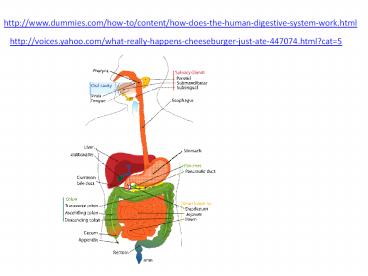http://www.dummies.com/how-to/content/how-does-the-human-digestive-system-work.html - PowerPoint PPT Presentation
1 / 5
Title:
http://www.dummies.com/how-to/content/how-does-the-human-digestive-system-work.html
Description:
The large intestine houses over 700 species of ... which is a mixture of nitrogen and carbon ... They are also involved in the production of cross-reactive ... – PowerPoint PPT presentation
Number of Views:29
Avg rating:3.0/5.0
Title: http://www.dummies.com/how-to/content/how-does-the-human-digestive-system-work.html
1
http//www.dummies.com/how-to/content/how-does-the
-human-digestive-system-work.html
http//voices.yahoo.com/what-really-happens-cheese
burger-just-ate-447074.html?cat5
2
(No Transcript)
3
(No Transcript)
4
(No Transcript)
5
- The large intestine houses over 700 species of
bacteria that perform a variety of functions. - The large intestine absorbs some of the products
formed by the bacteria inhabiting this region.
Undigested polysaccharides (fiber) are
metabolized to short-chain fatty acids by
bacteria in the large intestine and absorbed by
passive diffusion. The bicarbonate that the large
intestine secretes helps to neutralize the
increased acidity resulting from the formation of
these fatty acids. - These bacteria also produce large amounts of
vitamins, especially vitamin K and biotin (a B
vitamin), for absorption into the blood. Although
this source of vitamins, in general, provides
only a small part of the daily requirement, it
makes a significant contribution when dietary
vitamin intake is low. An individual that depends
on absorption of vitamins formed by bacteria in
the large intestine may become vitamin-deficient
if treated with antibiotics that inhibit other
species of bacteria as well as the
disease-causing bacteria. - Other bacterial products include gas (flatus),
which is a mixture of nitrogen and carbon
dioxide, with small amounts of the gases
hydrogen, methane, and hydrogen sulphide.
Bacterial fermentation of undigested
polysaccharides produces these. The normal flora
is also essential in the development of certain
tissues, including the cecum and lymphatics. - They are also involved in the production of
cross-reactive antibodies. These are antibodies
produced by the immune system against the normal
flora, that are also effective against related
pathogens, thereby preventing infection or
invasion. - The most prevalent bacteria are the bacteroides,
which have been implicated in the initiation of
colitis and colon cancer. Bifidobacteria are also
abundant, and are often described as 'friendly
bacteria'.






























